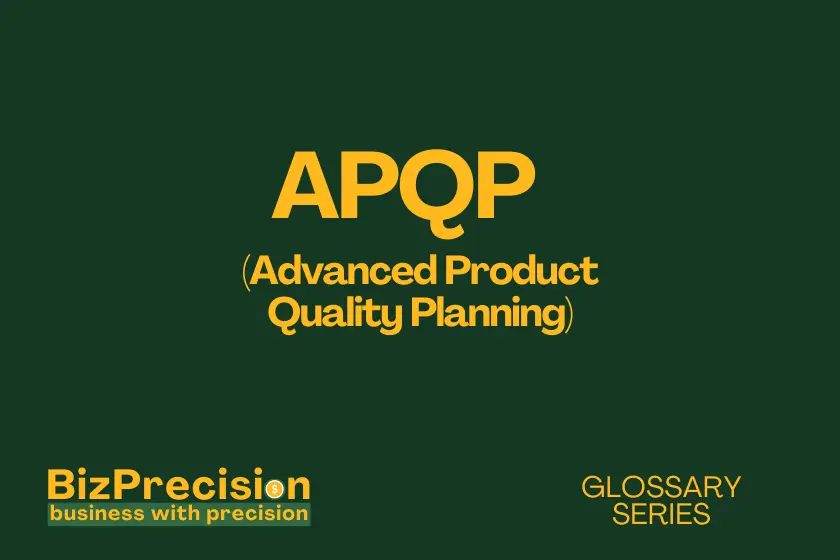What is APQP (Advanced Product Quality Planning)?
Advanced Product Quality Planning (APQP) is a structured method for product development and quality management used to create high-quality products that meet customer requirements.
APQP helps manufacturing teams reduce risks and ensure smooth product launches. According to a 2023 Quality Magazine survey of automotive manufacturers, companies using APQP reported a 45% reduction in product development time and a 60% decrease in quality-related issues during launch.
You’ll discover how APQP can transform your product development process and boost your quality metrics while cutting costs. Let’s explore the key elements that make APQP such a powerful tool for manufacturing success.
Core Components of APQP
Planning and Defining Phase
The planning phase sets the foundation for product success. You start by gathering customer needs and creating a solid project timeline.
Key activities in this phase include:
- Voice of Customer (VOC) Analysis – This step captures exact customer requirements and expectations. Teams use surveys, interviews, and market research to understand what customers truly need. The data helps shape product specifications and quality targets.
- Project Timeline Development – You’ll map out key milestones and deadlines for the entire project. Most APQP projects take 12-18 months from concept to launch. Clear timelines help teams stay on track and meet delivery dates.
- Resource Planning – This involves identifying needed equipment, personnel, and materials. Teams assess current capabilities and plan for any gaps. Good resource planning prevents costly delays later.
Product Design and Development
During this phase, you’ll turn customer requirements into detailed product specifications.
Essential design activities include:
- Design Specifications – Engineers create detailed drawings and technical requirements. These documents guide prototype development and testing. Clear specs reduce errors and rework during production.
- Design Verification – Teams test prototypes against customer requirements. Testing catches design flaws early when changes cost less. Data shows early verification can cut development costs by 30%.
- Design Reviews – Cross-functional teams examine designs for potential issues. Regular reviews improve product quality and reduce late-stage changes. Monthly design reviews are standard practice.
Process Design and Development
This phase focuses on creating efficient, capable manufacturing processes.
Critical process elements include:
- Manufacturing Flow Planning – Teams map out each production step in detail. Clear process flows help identify quality control points. Well-planned flows can boost productivity by 25%.
- Quality Control Strategy – You’ll define inspection points and measurement methods. Good quality controls catch defects before they reach customers. Teams typically place controls at critical process steps.
- Equipment and Tooling Plans – This covers machine specifications and custom tool needs. Proper planning prevents production delays and quality issues. Early tooling plans can reduce launch delays by 40%.
Product and Process Validation
The validation phase proves your design and process can consistently meet requirements.
Key validation steps include:
- Production Trials – Teams run sample production runs to test processes. Trial runs help identify and fix issues before full production. Most companies run 3-5 trial productions.
- Measurement Systems – You’ll verify that inspection methods are accurate and reliable. Good measurement systems ensure consistent quality control. Teams should achieve 90% or higher measurement accuracy.
- Production Approval – Final checks confirm readiness for full production. All quality metrics must meet targets before approval. This step typically takes 2-4 weeks to complete.
Benefits and Implementation
Quality Improvement Impact
APQP delivers measurable improvements in product quality and business performance. Recent studies from the International Journal of Quality & Reliability Management show remarkable results.
Key quality benefits include:
- Defect Reduction – Companies using APQP report up to 70% fewer defects in new products. Regular quality checks throughout development catch issues early. This early detection saves an average of $50,000 per project.
- Cost Savings – Better planning leads to fewer expensive late-stage changes. Manufacturing costs typically drop 15-20% with APQP methods. Teams spend less time fixing problems and more time improving processes.
- Customer Satisfaction – Products meet customer needs more consistently with APQP. Survey data shows a 40% increase in customer satisfaction scores. Happy customers lead to more repeat business and referrals.
Risk Management Advantages
APQP helps teams spot and solve problems before they affect production.
Major risk management benefits include:
- Early Problem Detection – Teams find issues during planning rather than production. Finding problems early costs 5-10 times less to fix. Regular design reviews catch 80% of potential issues.
- Supply Chain Coordination – Better planning helps suppliers prepare for production. Clear communication reduces material shortages by 60%. Teams can order long-lead items before they cause delays.
- Change Management – APQP provides a structured way to handle design changes. Organized change processes prevent confusion and mistakes. Changes cost 50% less when managed through APQP.
Cross-functional Collaboration
APQP brings different departments together to improve product quality.
Key collaboration elements include:
- Team Structure – Clear roles help everyone understand their responsibilities. Teams typically include design, manufacturing, and quality staff. Regular meetings keep everyone moving toward shared goals.
- Communication Methods – Standard forms and checklists improve information sharing. Teams use digital tools to track progress and decisions. Better communication reduces mistakes by 45%.
- Decision Making – APQP provides clear steps for reaching team decisions. Data-driven choices lead to better outcomes. Teams solve problems 30% faster with structured decision processes.
APQP in Modern Manufacturing
Industry Applications
APQP works well in many manufacturing sectors beyond automotive.
Current industry uses include:
- Aerospace Implementation – Aircraft makers use APQP to ensure safety and quality. The method has cut development time by 25% in aerospace projects. Strict documentation helps meet safety regulations.
- Medical Device Manufacturing – APQP helps meet FDA requirements for medical products. Companies report 40% fewer quality issues during product launches. The structured approach supports compliance and patient safety.
Integration with Other Quality Systems
APQP works well with other quality improvement methods.
Common integration areas include:
- ISO 9001 Alignment – APQP supports ISO quality management requirements. The methods share common goals and approaches. Together they create stronger quality systems.
- Six Sigma Connection – APQP’s data-driven approach fits with Six Sigma tools. Teams use both methods to reduce defects and variation. Combined use improves results by 35%.
Digital Transformation
Modern technology makes APQP more effective and easier to use.
Key digital advances include:
- Software Solutions – Digital tools help teams track APQP progress. Cloud systems improve collaboration and data sharing. Software cuts administrative time by 50%.
- Real-time Monitoring – Digital systems provide instant quality data access. Teams can spot trends and problems quickly. Fast responses prevent quality issues from spreading.
Conclusion
APQP provides a proven path to better products and happier customers. By following its structured approach, you’ll catch problems early, cut costs, and launch products smoothly.
Start by adopting basic APQP tools in your next project. Focus on clear planning, team communication, and regular quality checks. As your team gains experience, add more advanced elements.
Ready to improve your product quality? Begin implementing APQP basics today. Your customers and bottom line will thank you.







